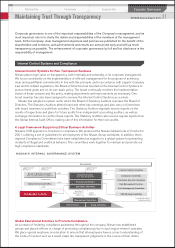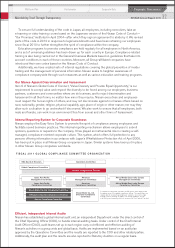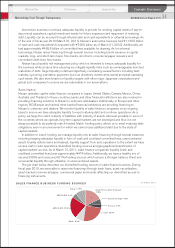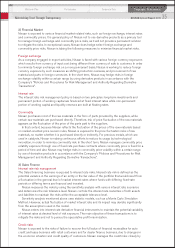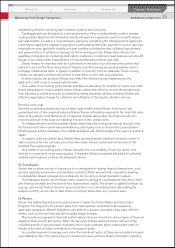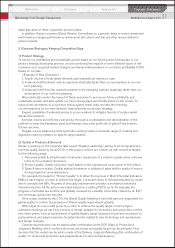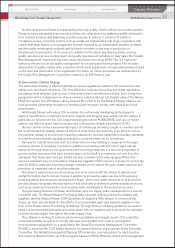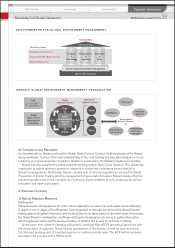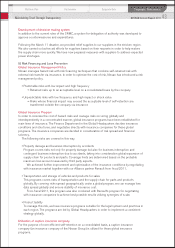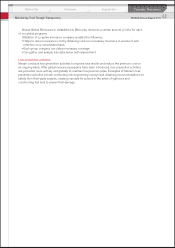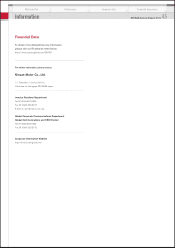Nissan 2011 Annual Report Download - page 42
Download and view the complete annual report
Please find page 42 of the 2011 Nissan annual report below. You can navigate through the pages in the report by either clicking on the pages listed below, or by using the keyword search tool below to find specific information within the annual report.
Maintaining Trust Through Transparency
Additionally, based on the policy of contribution to local society, we reacted rapidly to provide rest
space to people who could not return home on March 11 and to support damaged areas.
At the stage of business recovery, Disaster Headquarters and project teams of each function
continuously shared up-to-date information and were addressing the issues for production and
business recovery with companywide cooperation. It was effective for quick recovery of our total
supply chain including parts supply, production, logistics, sales and services.
The Global Headquarters building, where the Disaster Headquarters was set up (built in August
2009), has an earthquake-resistant structure using vibration-controlling brace dampers. Safety is
assured even in case of a maximum-level earthquake at the site. Inspections after the shocks
confirmed that the building has completely no trouble with its safety and functions.
2) Pandemic
In response to the outbreak of H1N1 type influenza in April 2009, Nissan established a global policy
for infection prevention. Each region has organized a response team and has promoted concrete
countermeasures based on the policy. Infection status can be monitored globally thanks to firmly
developed reporting lines between the global response team and each regional team.
Nissan has promoted countermeasures based on three basic principles stated in the global
policy, which are:
1. First priority on employees’ health and lives
2. Prevention of infection spread
3. Continuity of business operation
As specific actions, Nissan established “guidelines for employees’ action” which stipulated actions
to be taken by employees, Sections and Companies, and kept employees informed.
Nissan also prepared by developing a Business Continuity Plan (BCP) in each business section,
with several triggers to invoke the BCP depending on the infection ratio, to maintain continuity of
business even under a high infection ratio.
Nissan will keep prepared for contingencies like H5N1 avian flu through its PDCA cycle, such as
by updating response team members and the BCP, carrying out educational activities for infection
prevention and stockpiling sanitary and medical goods. Additionally, as a system for work-at-home
was already prepared as one pandemic countermeasure, it helped provide a quick solution for
commuting problems due to train stoppages and gasoline shortages following the March 11 disaster
in Japan.
3) Countermeasures for Production Continuity Risk
Nissan’s production division has dealt with various risks related to production activity.
Countermeasures were taken by three elements of production as listed on the chart below.
Particularly for natural disasters, we have worked on continuous prevention countermeasures to
hardware (reinforcement of buildings and machinery), development of recovery manuals in order to
shorten recovery time after an earthquake and regularly conducted BCP simulations. Due to
reinforcement measures continuously done from 2003, physical damage to Nissan facilities in the
March 11 disaster was minimized. For damaged plants, recovery support teams suitable for the
damage situation were quickly dispatched and recovery was achieved in a short time with support
from business partners. As a result Nissan restarted production activity quickly.
On the other hand, we have recognized the necessity of reviewing assumptions in some areas.
We will work on, in particular, tsunami countermeasures, risk evaluation of Tier-N and other suppliers
and complementary production systems.
In addition to such countermeasures to natural disasters, it is absolutely important to manage
quality risk of purchased parts from Leading Competitive Countries (LCCs) to improve quality level
and prevent leakage of unsatisfactory products in order to expand markets globally. To deal with
such risk, Nissan has been conducting risk assessment before making sourcing decisions, providing
support for improvement activities after sourcing and implementing quality checks at key points in
the production and logistics process.
In 2011, we will enhance the activities to minimize supply capacity risk from such LCC suppliers,
as well as the activities with respect to quality risk, in order to secure global market expansion and
growth.
Corporate Governance
Performance Corporate DataMid-term Plan
41
NISSAN Annual Report 2011


